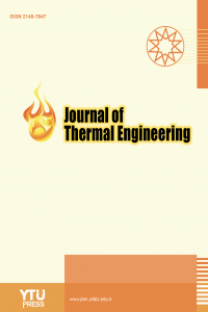OPTIMIZATION OF THE PERFORMANCE OF VAPOUR COMPRESSION CYCLE USING LIQUID SUCTION LINE HEAT EXCHANGER
Coefficient of Performance Liquid Suction Line Heat Exchanger, Subcooling, Vapour Compression Cycle,
___
- [1] Kubota T, Jeong S, Toe DHC, Ossen DR. Energy consumption and air-conditioning usage in residential buildings of Malaysia. J Int Dev Coop, 2011;17(3):61-9.
- [2] Naif A, Al-Obaidi ASM, Nassir MH. Effect of evaporator heater power input and refrigerant flow rate on the performance of a refrigerator - Developing empirical models. J Mech Eng Autom, 2015; 5(1):20-8. https://doi.org/10.5923/j.jmea.20150501.03.
- [3] Park C, Lee H, Hwang Y, Radermacher R. Recent advances in vapor compression cycle technologies. Int J Refrig, 2015;60:118-34. https://doi.org/10.1016/j.ijrefrig.2015.08.005.
- [4] Qureshi BA, Zubair SM. Mechanical sub-cooling vapor compression systems: Current status and future directions. Int J Refrig, 2013; 36(8):2097-2110. https://doi.org/10.1016/j.ijrefrig.2013.07.026.
- [5] Pottker G, Hrnjak P. Effect of the condenser subcooling on the performance of vapor compression systems. Int J Refrig, 2015;50:156-64. https://doi.org/10.1016/j.ijrefrig.2014.11.003.
- [6] Aprea C, Ascani M, de Rossi F. A criterion for predicting the possible advantage of adopting a suction / liquid heat exchanger in refrigerating system. Appl Therm Eng, 1999;19(4):329-36. https://doi.org/10.1016/S1359- 4311(98)00070-2.
- [7] Domanski PA, Didion D.A, Doyle JP. Evaluation of suction-line/liquid -line heat exchange in the refrigeration cycle. Int J Refrig, 1994;17(7):487-93.
- [8] Klein SA, Reindl DT, Brownell K. Refrigeration system performance using liquid-suction heat exchangers. Int J Refrig, 2000;23(8):588-96. https://doi.org/10.1016/S0140-7007(00)00008-6.
- [9] Navarro-esbrí J, Molés F, Barragán-cervera Á. Experimental analysis of the internal heat exchanger influence on a vapour compression system performance working with R1234yf as a drop-in replacement for R134a. Appl Therm Eng, 2013;59(1-2):153-61. https://doi.org/10.1016/j.applthermaleng.2013.05.028.
- [10] Pottker G, Hrnjak P. Experimental investigation of the effect of condenser subcooling in R134a and R1234yf air-conditioning systems with and without internal heat exchanger. Int J Refrig, 2015;50:104-13. https://doi.org/10.1016/j.ijrefrig.2014.10.023.
- [11] Devecioğlu AG, Oruç V. The influence of plate-type heat exchanger on energy efficiency and environmental effects of the air-conditioners using R453A as a substitute for R22. Appl Therm Eng, 2017;112: 1364-72. https://doi.org/10.1016/j.applthermaleng.2016.10.180.
- [12] Zhang J, Desideri A, Kærn MR, Ommen TS, Wronski J, Haglind F. Flow boiling heat transfer and pressure drop characteristics of R134a , R1234yf and R1234ze in a plate heat exchanger with conditions prevailing in the evaporator of organic Rankine cycle units. Int J Heat Mass Transf, 2017;108(Part B): 1787-801. https://doi.org/10.1016/j.ijheatmasstransfer.2017.01.026.
- [13] Imran M, Usman M, Yang Y, Park B-S. Flow boiling of R245fa in the brazed plate heat exchanger: Thermal and hydraulic performance assessment. Int J Heat Mass Transf, 2017;110:657-70. https://doi.org/10.1016/j.ijheatmasstransfer.2017.03.070.
- [14] Longo GA, Gasparella A. Refrigerant R134a vaporisation heat transfer and pressure drop inside a small brazed plate heat exchanger. Int J Refrig, 2007;30(5):821-30. https://doi.org/10.1016/j.ijrefrig.2006.11.011.
- [15] Yan Y-Y, Lin T-F. Evaporation heat transfer and pressure drop of refrigerant R-134a in a plate heat exchanger. J Heat Transf, 1999;121(1):118-27. https://doi.org/10.1115/1.2825924.
- [16] Jassim EW, Newell TA, Chato JC. Refrigerant pressure drop in chevron and bumpy style flat plate heat exchangers. Exp Therm Fluid Sci, 2006;30(3):213-22. https://doi.org/10.1016/j.expthermflusci.2005.05.008.
- [17] Huang J, Sheer TJ, Bailey-Mcewan M. Heat transfer and pressure drop in plate heat exchanger refrigerant evaporators. Int J Refrig, 2012;35(2):325-35. https://doi.org/10.1016/j.ijrefrig.2011.11.002.
- [18] Rahman MM, Rahman HY. Hydrocarbon as refrigerant for domestic air conditioner : a comparative study between R22 and R290. Therm Eng, 2012;53:11976-79.
- Yayın Aralığı: 6
- Başlangıç: 2015
- Yayıncı: YILDIZ TEKNİK ÜNİVERSİTESİ
MONTHLY DESIGNDATAFOR MAXIMUM SOLAR RADIATION FALLING ON COLLECTOR ARRAYS INBAGHDAD CITY
Ekansh CHATURVEDİ, Vijay MAMTANİ
Om PARKASH, Rajesh ARORA, Shofique Uddin AHMED
Khizar Ahmed PATHAN, P. S. DABEER, S. A. KHAN
Shubhashis SANYAL, Nisha NETAM, Shubhankar BHOWMİCK
Ahmet YURTSEVEN, Kaan ÜNLÜGENÇOĞLU, Fuat ALARÇİN
Abdulkareem Sh. Mahdi AL-OBAİDİ, Ali NAİF, Thabit Khalifa AL-HARTHİ
SOLAR HYDROGEN PRODUCTION BY THERMOCHEMICAL REACTION:DEVELOPMENT OF A PACKED-BED REACTOR
D. DARFİLAL, C. SELADJİ, R. BHANDARİ
M. HATAMİ, S. MOSAYEBİDORCHEH, T. MOSAYEBİDORCHEH, M. VATANİ, D.D. GANJİ
